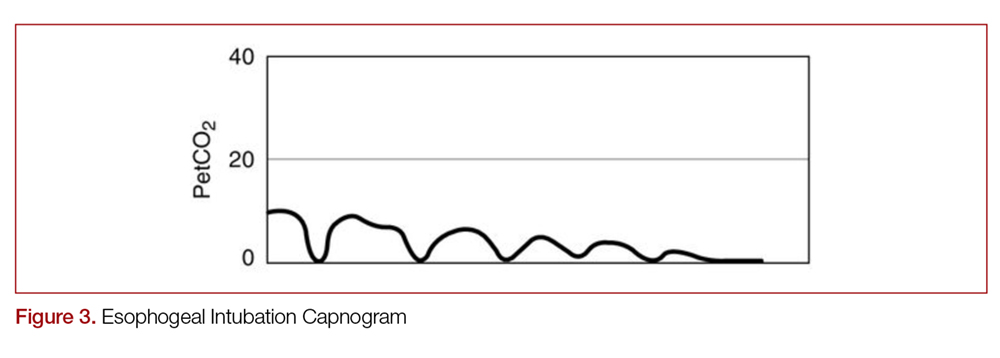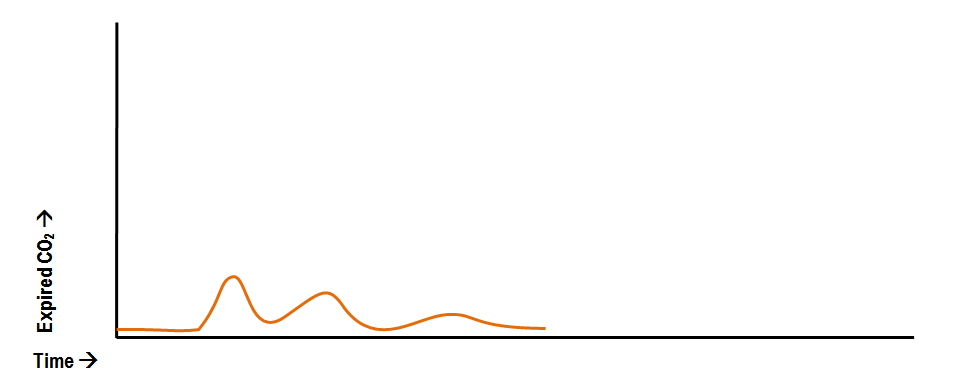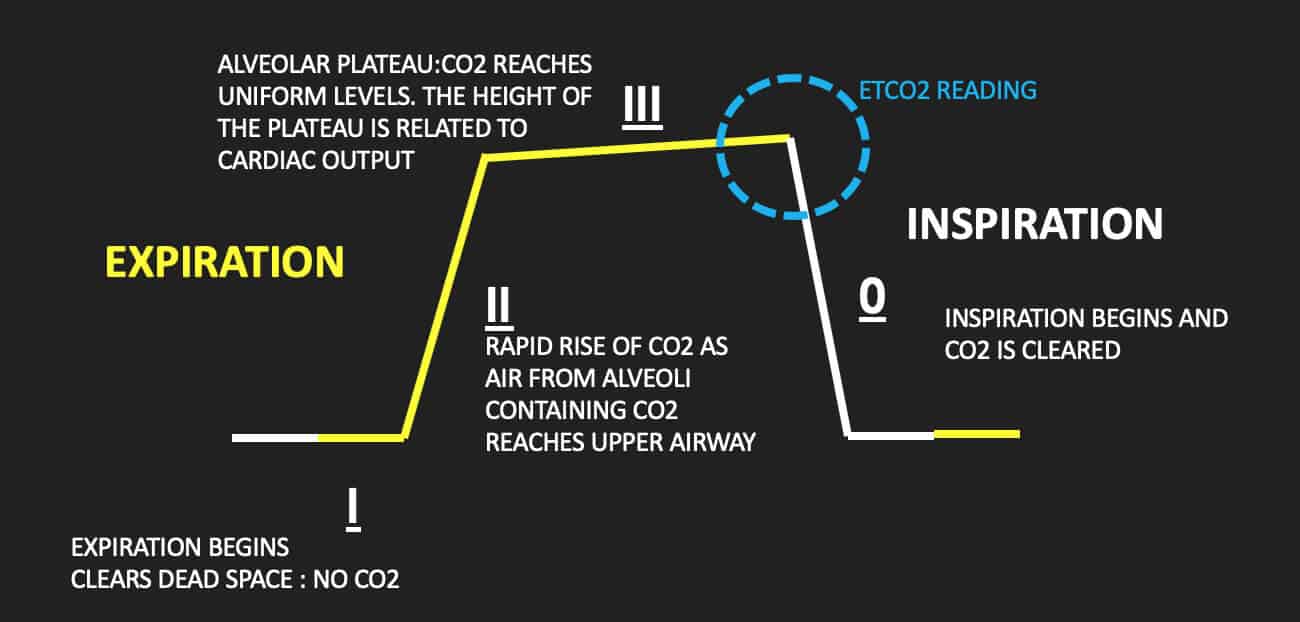normal end tidal co2 after intubation
What is end-tidal CO2 etCO2. Selby DO Thomas Abramo MD and Nicholas Hobart-Porter DO Abstract.
In these cases waveform morphology was normal and continued to the 2 min cessation point.

. End tidal normally 2-5 mmHg lower than arterial Comparing Arterial and End-tidal CO2 Review of Airway Confirmation Visualization Auscultation. End-tidal CO2 diminishes over time Sudden increase in ETCO2. End-tidal CO 2 ETCO 2 monitoring is not a new modality in the pediatric emergency department PED and emergency department.
Measurement of end-tidal carbon dioxide ETCO2 has been used to detect accidental esophageal tube placement in noncardiac arrest situations. 2 to near normal normal EtCO 2 35-45 mmHg represents marked increase of CO 2 delivery to lungs suggesting ROSC If patient develops an organized rhythm after VFVTasystole check EtCO 2 to see if ROSC has occurred CONFIRM PLACEMENT OF ETT After intubation if ETCO 2 10mm Hg tube in trachea. End-tidal CO2 measurement in the detection of esophageal intubation during cardiac arrest.
When CO2 diffuses out of the lungs into the exhaled air a device called a capnometer. The purpose of our study was to determine whether ETCO2 measurement could distinguish tracheal from esophageal tube. This is end-tidal CO 2 ETCO 2 which is normally 35 to 45 mm Hg in dogs and 28 to 32 mm.
Return of spontaneous circulation. Capnograph is an indispensable tool for monitoring metabolic and respiratory function. Waveform capnography represents the amount of carbon dioxide CO 2 in exhaled air which assesses ventilation.
Waveform and end -tidal carbon dioxide EtCO2 values. The number represents capnometry which is the partial pressure of CO 2 detected at the end of exhalation. Misting increased SaO2 Types of End-Tidal CO2 Qualitative Yes or No.
End tidal carbon dioxide ETCO 2 monitoring is a more objective method812 and is recommended as the best method to confirm correct ETT placement by the 2015 International Consensus on Cardiopulmonary Resuscitation13 In a study of 100 intubation episodes 39 of 40 oesophageal intubations were correctly identified by ETCO 2 monitoring using capnography. ETCO2 emergency department monitoring and critical. Videos of the waveforms are available as online supplementary files numbers 18.
Changes in the shape of the capnogram are diagnostic of disease conditions while changes in end-tidal CO 2 EtCO 2 the maximum CO 2 concentration at the end of each tidal breath can be used to assess disease severity and response to treatment. Capnography is also the most reliable indicator that an endotracheal tube is placed in the trachea after intubation. We have previously demonstrated life-like end-tidal capnography ETCO 2 waveforms following tra-cheal intubation of two fresh-frozen cadavers1 This has highlighted the potential for use of cadavers in airway management simulation training.
Measuring end-tidal CO2 in cardiac arrest patients is helpful for confirming tracheal tube placement assessing the effectiveness of chest compressions predicting likelihood of return of spontaneous circulation ROSC in that a persistently low ETCO2 tends to predict death whereas a high or rising ETCO2 is associated with a higher chance of ROSC. End tidal CO 2 monitoring is represented as a number and a graph on a monitor. The waveform is called capnograph and shows how much CO 2 is present at each phase of the respiratory cycle.
The number is called capnometry which is the partial pressure of CO 2 detected at the end of exhalation ranging between 35 - 45 mm Hg or 40 57 kPa. An Update on End-Tidal CO2 Monitoring Samuel T. In this study the aim was to review the applications of end-tidal carbon dioxide ETCO2 monitoring in emergency department multiple databases were comprehensively searched with combination of following keywords.
Silvestri S Ralls GA Krauss B Thundiyil J Rothrock SG Senn A et al. Norm al EtCO2 levels 46 to 60 kPa signify adequate perfusion. EtCO2 is a measurement of the partial pressure of CO2 in gas expired at the end of exhalation when exhaled gas will most closely resemble the alveolar CO2 concentration.
The indicator is purple which indicates failure to detect CO2. The normal values are 5-6 CO2 which is equivalent to 35-45 mmHg. A prospective clinical trial was conducted at a level I trauma center to assess the efficacy of end-tidal carbon dioxide CO2 detection in four groups of patients requiring emergency intubation because of cardiac arrest major trauma respiratory failure or.
Consistent waveform and end-tidal CO2 20 kPa. With previously normal pCO 2 or acute rise of 10 or more torr. Rapid Sequence Intubation Figure 1-3 End-tidal CO2 detector before application.
Capnography can be used to assess unresponsive patients ranging from those are actively seizing to victims of chemical terrorism. Waveform capnography should be monitored in all intubated patients and displayed on the monitor as above. The presence of a normal waveform denotes a patent airway and spontaneous breathing.
The second intubation showed a normal end-tidal carbon dioxide wave form that declined over a minute accompanied by decreasing oxygen saturation. It is pos-sible that carbon dioxide CO 2 remains in the lungs postmortem and is liberated by artificial ven-. Finally the endotracheal tube was found to be in the esophagus at postmortem.
End-tidal capnography or end-tidal CO2 EtCO2 monitoring is a non-invasive technique that measures the partial pressure or maximal concentration of carbon dioxide CO2 at the end of an exhaled breath. The effectiveness of out-of-hospital use of continuous end-tidal carbon dioxide monitoring on the rate of unrecognized misplaced intubation within a regional emergency medical services system. This is t he appearance when the esophagus is intubated.
As effective CPR leads to a higher cardiac output ETCO2 will rise reflecting the increase in perfusion. It consists of a number and a graph. Negative Epigastric sounds Equal lung sounds Esophageal detector End tidal CO2 detector Secondary signs.
For two cadavers life-like ETCO 2 waveforms were achieved immediately after tracheal intubation with maximum ETCO 2 achieved by the second breath.

End Tidal Capnography In The Emergency Department Mdedge Emergency Medicine

End Tidal Co2 Respiratory Therapy Tidal Co2

Capnography Nursing Procedures Icu Nursing Nursing School Studying

Waveform Capnography In The Intubated Patient Emcrit Project

Different Capnography Traces A Sudden Drop In E 0 Co2 B Download Scientific Diagram

3 Waveform Capnography Showing Changes In The End Tidal Carbon Dioxide Download Scientific Diagram

Ventilator Waveform Troubleshooting This Onepager Explains How You Can Rapidly Determine If High Icu One Pager Pagers
Emdocs Net Emergency Medicine Educationcapnography In The Ed Emdocs Net Emergency Medicine Education

The Impact Of Ventilation Rate On End Tidal Carbon Dioxide Level During Manual Cardiopulmonary Resuscitation Resuscitation

Waveform Capnography In The Intubated Patient Emcrit Project

Waveform Capnography In The Intubated Patient Emcrit Project
Eurasian Journal Of Emergency Medicine
Eurasian Journal Of Emergency Medicine

Reversible Causes Of Low Etco2 In Cpr Criticalcarenow

What S In A Wave Form Utilizing End Tidal Capnography For More Than Intubation Confirmation Criticalcarenow

Abnormal Capnography Waveforms And Their Interpretation Deranged Physiology

